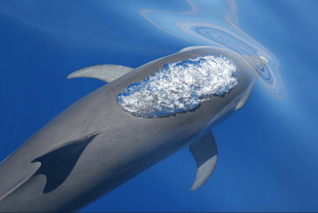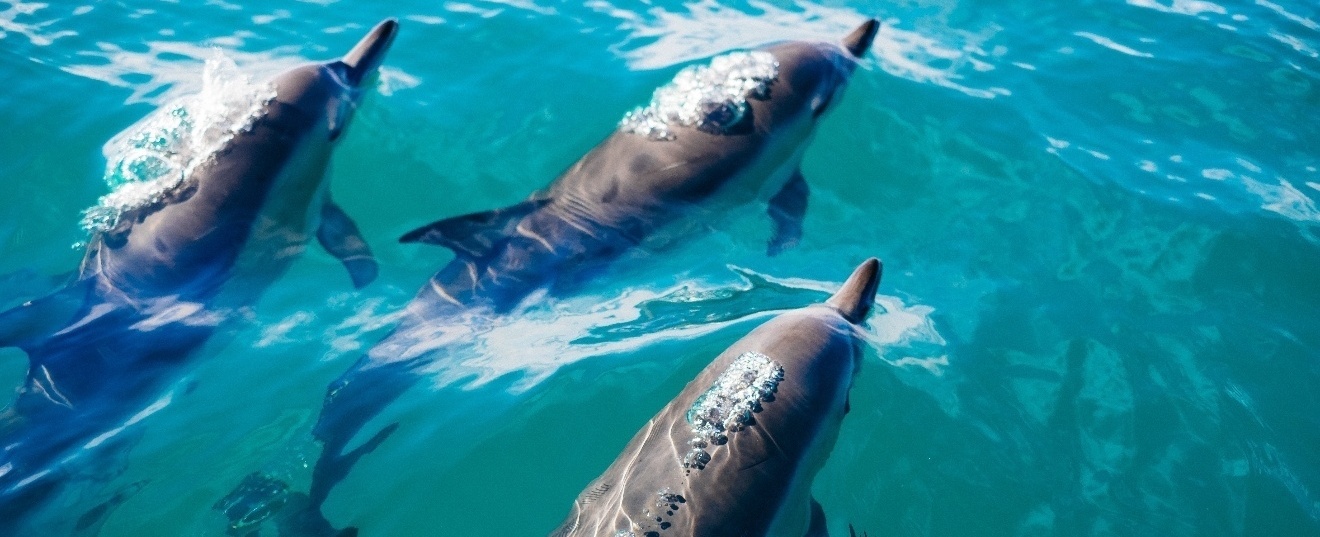Fun to watch, highly intelligent and endlessly fascinating, dolphins are widely researched marine mammals belonging to the toothed whale family that includes pilot whales and orcas. How dolphins communicate through a variety of whistles, giggles and "raspberries" is both remarkable and indicative of their superior ability to initiate and maintain social bonds. What's also amazing is the way dolphins control blowhole muscles to make these sounds. By manipulating and contracting the size of the blowhole and altering its shape, dolphins "communicate" to other dolphins in their and other pods, even groupings miles away. Dolphins in captivity also use these same sounds to communicate with other dolphins and to get the attention of their caretakers!
Here is a closer look at three types of dolphin communication:
Prepare to be astonished by the complex, elaborate system of communication dolphins have evolved since their appearance on Earth approximately five million years ago.
1. Signature Whistles
Signature whistles are distinctive whistles produced by dolphins characterized by frequency modulation patterns that encode identity information. Dolphins develop signature whistles early in life (by two years of age) but some individuals may alter them after using a particular signature whistle for several years. Male dolphins especially tend to change signature whistles upon forming an alliance with another dolphin. Other research has discovered that dolphin groups meeting at sea routinely exchange signature whistles to offer identity information and facilitate socializing. In other words, when groups of dolphins encounter each other, they immediately engage
Dolphins are known to occasionally copy another dolphin's signature whistle. To gain further insight into why dolphins copy signature whistles, researchers recorded the calls of both wild and captive dolphins. Their results found that copying exclusively occurred between dolphins with socially close bonds, (calves and mothers or young captive males, for example). In addition, dolphins typically copied a signature whistle soon after their mother, offspring or pod member whistled. One theory explaining why dolphins copy each other's signature whistles states that dolphins may be "calling" other dolphins. It may be a way of eliciting acknowledgement from a pod member or to signal that they are nearby and available for social interactions, or to join their group.
2. Echolocation
Dolphin communication also involves echolocation, a way using sound waves to find food, other dolphins and relevant ocean objects hundreds of yards from their current location. By producing burst pulse, broad-spectrum emissions sounding like clicks to humans, dolphins accurately determine the location of an object in which they are interested. The sound waves reflect off the object back to the dolphin, specifically to a highly evolved, fat-rich area in a dolphin's lower jaw. Transmission of this acoustic information from the jaw to the middle ear to the brain allows the dolphin to rapidly interpret and process the information.
 Echolocation in dolphins is so finely honed that they can tell the difference between a ping-pong ball and golf ball by evaluating the density of the object. Supporting a dolphin's ability to use echolocation so successfully is also how well water conducts sounds. Since sound waves travel over four times faster under water than in air, dolphins seem to be the superior utilizers of echolocation among mammals. Another fascinating tidbit about echolocation comes from research into how this ability evolved in dolphins and bats.
Echolocation in dolphins is so finely honed that they can tell the difference between a ping-pong ball and golf ball by evaluating the density of the object. Supporting a dolphin's ability to use echolocation so successfully is also how well water conducts sounds. Since sound waves travel over four times faster under water than in air, dolphins seem to be the superior utilizers of echolocation among mammals. Another fascinating tidbit about echolocation comes from research into how this ability evolved in dolphins and bats.
A 2010 study discovered that bats and dolphins have identical mutations of prestin, a genetic protein affecting hearing sensitivity. Investigation of additional genes influencing hearing further found that prestin and other proteins changed in bats and dolphins, making a strong case for convergent evolution of echolocation in bats and dolphins.
3. Social Communication
Dolphins emit whistles while socially interacting, specifically to relay their state, and if they have been separated from pod members. In addition to signature whistles and echolocation, dolphins also communicate non-vocally, meaning they do not use vocal area organs, such as the larynx and air sacs. Hitting the water's surface hard with their tail (tail slapping) is a non-vocal sign of discontent, can deter predators but it could also be a way of signaling the dolphin group it is time to leave a particular area. Researchers have concluded that tail slapping is indeed an attention-getting sound that could simply be a way of signaling effectively without vocalizing.
Dolphins removing their whole body or part of their body from the water and then crashing forcefully back onto the water's surface is called "breaching". Although breaching may occur because a dolphin trying to dislodge parasites, it is predominantly used to communicate locations and to assist in herding prey towards the group.
As research continues into dolphin communication, no doubt we will continue to be amazed at the intelligence and amiability these wonderful mammals possess.









